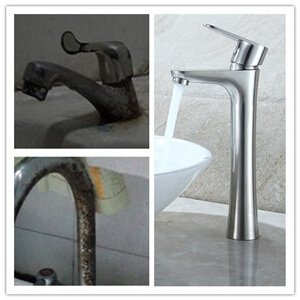Chrome faucet Vs Stainless Steel Faucets
If you gravitate toward shiny things and you’re in the market for a kitchen faucet, chrome and stainless steel finishes are good options because they are bright, durable and relatively low-maintenance.
The differences between chrome and stainless steel are subtle, and choosing between them ultimately comes down to personal preference and which finish best complements your kitchen sink and appliances.
These are popular options when budget is a consideration, as both cost less than nickel and bronze faucets.
Chrome for High Shine
Chrome faucets get their shiny finish from chrome electroplating over another metal.
Chrome is shinier than stainless steel, which is great for aesthetics but more challenging to keep clean.
Water spots and fingerprints are more noticeable on chrome because they contrast more sharply with the shine of the rest of the faucet.
Additionally, abrasive kitchen cleaners may mar chrome’s finish over time.
Stainless Steel for Easy Care
Shiny, but less so than chrome, stainless steel faucets are lower-maintenance because they disguise spots and smudges better than chrome.
Stainless steel is valued over chrome for its durability and scratch-resistance. Shoppers will find more stainless-steel faucet options from which to choose, as homeowners who need a faucet but don’t have an aesthetic preference frequently opt for stainless because of its low cost.
The service life more than 10 years, but the surface as new.
Stainless Steel Advantages
Stainless steel is durable, versatile and easy to maintain. Unlike chrome and nickel, it doesn’t display spots as easily and keeps its shiny appearance.
Daily maintenance can be as simple as cleaning the surfaces with a sponge and water, and drying with paper towels or a cloth. You do not have to purchase special cleaning formulas to restore the luster and shine.
In most cases, a small amount of hand pressure applied to the surface to buff and polish the stainless steel is all that’s necessary.
Comparison to Nickel
The finish of stainless steel is always shiny, whereas brushed nickel has a matte or semigloss finish. As a result, stainless steel will blend well if you have other stainless steel appliances and surfaces in a kitchen or bathroom, such as sinks.
It is also easier to match stainless steel faucets and fixtures, regardless of the faucet manufacturer. Brushed nickel, on the other hand, is more difficult to match and coordinate with other appliances, if not altogether impossible or cost-prohibitive. This makes it easier to create a seamless look between faucets and fixtures for kitchen appliances and fixtures by using stainless steel.
People who choose brushed nickel do so because they want the fixture and the brushed nickel finish to stand out and are not relying on the object to blend in seamlessly with other appliances and fixtures.
